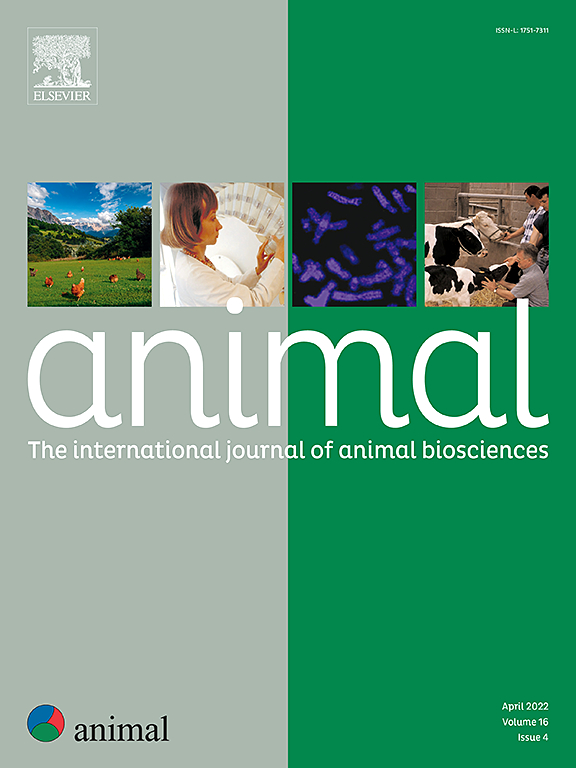圈舍中不同数量的稻草和堆肥对生长育肥猪的生根积极性有何影响?
IF 4
2区 农林科学
Q1 AGRICULTURE, DAIRY & ANIMAL SCIENCE
引用次数: 0
摘要
扎根是猪的一种具有强烈动机的特定行为。大多数饲养系统都没有提供能让猪充分表现这种行为的适当材料,而且稻草是否适合完全满足猪的生根动机仍不清楚。因此,我们研究了少量(最少)和大量(较深)稻草以及大量堆肥是否适合满足猪的生根动机。57 头生长发育中的猪被饲养在三个猪圈中,每个猪圈都可以永久接触到三种处理基质中的一种。每组八头猪分别接受经典偏好测试(PT)和条件性场所偏好测试(CPPT)。在试验中,猪可以表现出它们更喜欢吃可自由获得的饲料("饲料")或藏在锯末中的饲料("根")。在位置偏好试验中,饲料只在训练期间出现,而在测试期间不出现。猪分别在体重约为 72 千克和 115 千克的情况下接受两次测试。在两次测试中,都测量了以下变量,并将其作为线性混合效应模型中的结果变量:从两种刺激("饲料 "或 "树根")中选择其一的首次决策、在 "树根 "附近停留的时间、刺激之间的变化次数以及首次决策的潜伏期。总体而言,猪的首次决定(趋势;P = 0.076)和接近 "根 "的持续时间(P = 0.034)在不同处理之间存在差异:与堆肥饲养的猪相比,用最少秸秆饲养的猪往往更倾向于首先选择 "根"(事后比较;P = 0.090),在靠近 "根 "处停留的时间也更长(P = 0.030),而用深秸秆饲养的猪则处于中间位置。有趣的是,在首次决定(交互作用;P = 0.032)和接近 "根 "的时间(交互作用;按趋势;P = 0.006)方面,猪对处理的反应模式因行为测试而异。此外,PT 组的猪比 CPPT 组的猪更频繁地在不同刺激之间进行转换(P = 0.006)。本文章由计算机程序翻译,如有差异,请以英文原文为准。
How do different amounts of straw as well as compost in the home pen affect the rooting motivation of growing-finishing pigs?
Rooting is a strongly motivated, species-specific behaviour of pigs. Most housing systems do not provide appropriate materials that enable the full expression of this behaviour, and it remains unclear whether straw is suitable to entirely fulfil the rooting motivation of pigs. We therefore investigated the suitability of small (minimal) and large (deep) amounts of straw as well as large amounts of compost to satisfy rooting motivation in pigs. Fifty-seven growing-finishing pigs were housed in three pens, each providing permanent access to one of the three treatment substrates. Eight pigs per group were tested individually in a classical preference test (PT) and another eight pigs in a conditioned place preference test (CPPT). In the tests, pigs could show their preference to consume freely available feed (“feed”) or feed hidden in sawdust (“root”). In the CPPT, feed was only present during training but not during testing. Pigs were exposed to the test situation twice, with approximately 72 kg and 115 kg BW. In both tests, the following variables were measured and used as outcome variables in linear mixed effect models: first decision to choose one of the two stimuli (“feed” or “root”), duration of time spent in proximity to “root”, number of changes between stimuli, and latency to the first decision. Overall, the pigs’ first decision (by tendency; P = 0.076) and the duration in proximity to “root” (P = 0.034) varied among treatments: Pigs housed with minimal straw tended to be more likely to choose “root” first (posthoc comparison; P = 0.090) and spent more time in proximity to “root” (P = 0.030) than pigs housed with compost, whereas pigs housed with deep straw were intermediate. Interestingly, the patterns of response to the treatment differed depending on the behavioural tests for both, first decision (interaction; P = 0.032) and duration in proximity to “root” (interaction; by tendency; P = 0.006). In addition, pigs in the PT changed more often between stimuli than pigs in the CPPT (P < 0.001). There was a tendency for an interactive effect between test and treatment for latency to first decision (interaction; P = 0.082), though pairwise comparisons did not reveal any differences. We concluded that in this study housing with permanent access to compost satisfied rooting motivation in pigs more than housing with minimal amounts of straw.
求助全文
通过发布文献求助,成功后即可免费获取论文全文。
去求助
来源期刊

Animal
农林科学-奶制品与动物科学
CiteScore
7.50
自引率
2.80%
发文量
246
审稿时长
3 months
期刊介绍:
Editorial board
animal attracts the best research in animal biology and animal systems from across the spectrum of the agricultural, biomedical, and environmental sciences. It is the central element in an exciting collaboration between the British Society of Animal Science (BSAS), Institut National de la Recherche Agronomique (INRA) and the European Federation of Animal Science (EAAP) and represents a merging of three scientific journals: Animal Science; Animal Research; Reproduction, Nutrition, Development. animal publishes original cutting-edge research, ''hot'' topics and horizon-scanning reviews on animal-related aspects of the life sciences at the molecular, cellular, organ, whole animal and production system levels. The main subject areas include: breeding and genetics; nutrition; physiology and functional biology of systems; behaviour, health and welfare; farming systems, environmental impact and climate change; product quality, human health and well-being. Animal models and papers dealing with the integration of research between these topics and their impact on the environment and people are particularly welcome.
 求助内容:
求助内容: 应助结果提醒方式:
应助结果提醒方式:


